Now that they have the privilege of drafting Connor Bedard first overall, the Chicago Blackhawks have to go about actually building the rest of the team. It might seem a bit obvious, but we don't need to look very far in history, or just at the present, for the teams of generational talents to not find playoff success in the near-term, or even medium-term. The easy part is over with, and though they have prospects like Lukas Reichel and Frank Nazar, prospects are exactly that until proven at the NHL level.
Some of potential pieces are starting to be assembled as goaltender was Arvid Söderblom signed by Chicago:
He managed a .906 save percentage in his first 13 appearances in 2022-23 before falling off hard in his last couple games, and then the demotion. It looks like he's set to be the goaltending tandem with Petr Mrazek for 2023-24, though how valuable those starts could be is a matter for another day. The team still has lots of offseason in front of them, too.
*
A quick update on Teuvo Teravainen:
It is just to provide a bit of clarity on what Carolina's timeline might be for Teravainen. It's certainly not anytime soon, regardless of who eventually comes out of their series against New Jersey.
*
A comeback from a 3-0 series deficit truly takes a game-at-a-time mindset and Toronto took a big step in the right direction on Wednesday night, skating away with the Game 4 win by a 2-1 margin. Mitch Marner and William Nylander (PP) both scored, ending goalless droughts of several games for the both of them. The Marner goal was a wrist shot from 45 feet that went under Sergei Bobrovsky's arm. Sometimes, those are the kind of breaks that can lead to floodgates opening.
It was a great game from 24-year-old Leafs goalie Joseph Woll, who stopped 24 of 25 to backstop the victory. His lone goal against was a tic-tac-toe passing play where a Sam Reinhart one-timer from the slot on the power play leaked under his arm, and then poked in by Reinhart. Kind of hard to blame him for that and he was a stalwart otherwise. A great game for the kid to build some confidence.
Game 5 goes Friday night back in Ontario.
*
Keeping the theme with much of the second round, the Oilers ran away with Game 4 against the Golden Knights by a 4-1 margin. Even that score belies what really happened here as it was 3-0 after the first period and 4-0 after 40 minutes. Stuart Skinner held the fort by saving 25 of 26 shots in the win. That makes all four games in this series decided by at least two goals with the last three contests featuring at least a three-goal differential. Close, these games are not, and yet it feels as if seven games are inevitable.
The 3-0 lead for the Oilers was very much deserved as they carried a 12-4 scoring-chance differential after the first frame, and it kind of shows how quickly this game really ended. It was a good game from the Edmonton depth forwards, too, as Nick Bjugstad scored and they held Vegas to very, very little offensive zone time.
Ryan Nugent-Hopkins had a goal and an assist while Connor McDavid had a couple of helpers. With a power play goal in the first period. Evan Bouchard now has 34 points in his last 30 games, dating to the regular season. I cannot wait to see his ADP in September drafts.
Game 5 is also Friday night, back in Vegas.
*
The offseason fantasy reviews of each of the non-playoff teams continues today, and we head back to the Eastern Conference to cover another of the recent Stanley Cup winners in the Washington Capitals. We just covered the St. Louis Blues, another team in this mould, and the entire list of teams covered to this point is listed at the end.
This review will cover the successes/failures and improvements/declines from the players and team, all from a fantasy angle, while also taking a stab at where the Capitals go from here. For a team with as many fascinating stories as they have, there's no shortage of discussion to be had here.
As usual, we will be using data from our Frozen Tools or Natural Stat Trick, unless otherwise indicated.
Successes
There are three guys that stick out for fantasy success this year.
First, Alex Ovechkin reached the 40-goal mark for the 13th 40-goal season of his career. He saw goal, assist, and shot-per-game declines, but he was still the only played with at least 40 goals, 30 assists, 275 shots, and 150 hits this season. In fact, he was the only player with all that and just 100 hits. That across-the-board performance still made him incredibly valuable, though he's another guy whose value was dinged pretty hard in plus/minus formats.
It was also a very successful season for Dylan Strome. After being shunned by Chicago, he landed in Washington and set career-highs in goals (23), assists (42), power-play points (21), shots (154), and even improved his plus/minus from a season ago. He wasn't an elite option or anything, but he certainly showed he can be a depth fantasy option.
Though he was eventually traded, and his fantasy value was nuked because of it, Erik Gustafsson put up 38 points in 61 games for the Caps, including 14 PPPs, after posting just 18 such points over his prior 154 games. He is a free agent after the season, and it'll be interesting to see where he lands this summer because there's still some fantasy goodness to be had here. Though, we have seen this trick from Gustafsson before.
The last guy to mention, though certainly not the least, is Darcy Kuemper. He came over from Colorado following their Cup victory and had a very good season: 13.2 goals saved above expected, per Evolving Hockey, in over 1600 shots faced. That isn't elite, but it makes him an average full-time starter, and that's more than a lot of teams have. He may not have finished around his ADP – depending on the league – but he wasn't far, and considering all the injuries the team endured, that is a success.
Failures
Oh, yeah, those injuries.
Tom Wilson and Nicklas Backstrom started the season rehabbing knee and hip surgery, respectively. They did not return until January and combined for 72 games played. Neither was expected to do much in fantasy, though Wilson was good down the stretch (when healthy), but it is part of the larger picture.
John Carlson missed 42 games while TJ Oshie missed 24. Those four guys are all core pieces and missed 158 games, which is nearly two full seasons. In other words, though Wilson/Backstrom came back eventually, injuries to core pieces elsewhere had the effect as if Wilson/Backstrom never came back at all.
For that reason, it's hard to say most of these players were failures. Injuries are just part of the game and older players trying to return from serious surgeries is always a mixed bag. A full season from Carlson sees him push for 20 goals, 60 points, and 250 shots, for example.
The only guy I would call an outright failure, fantasy-wise, is Evgeny Kuznetsov. With Backstrom out and Lars Eller not really capable of top-line duties, it seemed there was a huge opportunity for Kuznetsov to have a big season playing heavy offensive minutes. The reality was an eight-year low in goals per game and points per game, combined with a year-over-year decline in assists and shots per game. His PP production also fell from 0.34 PPPs per game last season to 0.22 this season. That is a difference of 10 PPPs in an 82-game season.
The big reason for Kuznetsov's decline was the team shooting percentage. He had never had a season where the Capitals shot under 11% with him on the ice, and he had posted five straight seasons of at least 12.5%; by the end of 2022-23, the Caps shot 10.8% with Kuz on the ice. If the team shoots 13% instead, he easily adds 10 points to his total. Still a drop from last year, but more reasonable. The same goes for his personal shooting percentage (7%) against his three-year average (12.5%).
It wasn't as if he didn't create opportunities for teammates, either. His scoring chance assists per 60 minutes at 5-on-5 – SCA/60, or the rate at which Kuz assisted on a teammate's scoring chance – wasn't among the super-elite like Connor McDavid or Jack Hughes, but he was in the next tier with names like Jason Robertson and Kirill Kaprizov (from Corey Sznajder's tracking data, and the red line represents Kuz's rate):
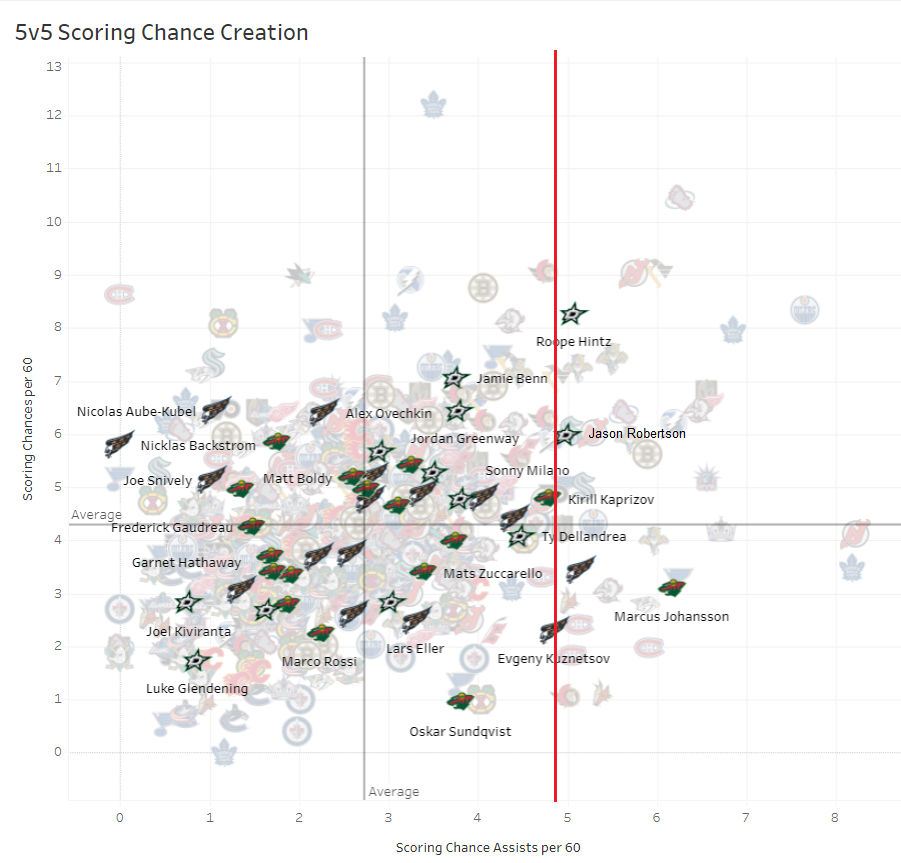
It did help him to 25 assists at 5-on-5, his highest mark in four years. It is also lower than what he did in 2015-16, 2017-18, and 2018-19. He did his best to help his teammates score, and did more than almost everyone else on that roster in this respect, but he reached his limit.
The last note on Kuz is that though his SCA/60 was excellent, his individual scoring chance rate was not: lower than forwards like Christian Fischer, Ryan Reaves, and MacKenzie Entwistle. The big reason was he shot from absolutely everywhere: on the left, from HockeyViz, is Kuz's shots at 5-on-5 in 2019-20, and his most recent season is on the right:
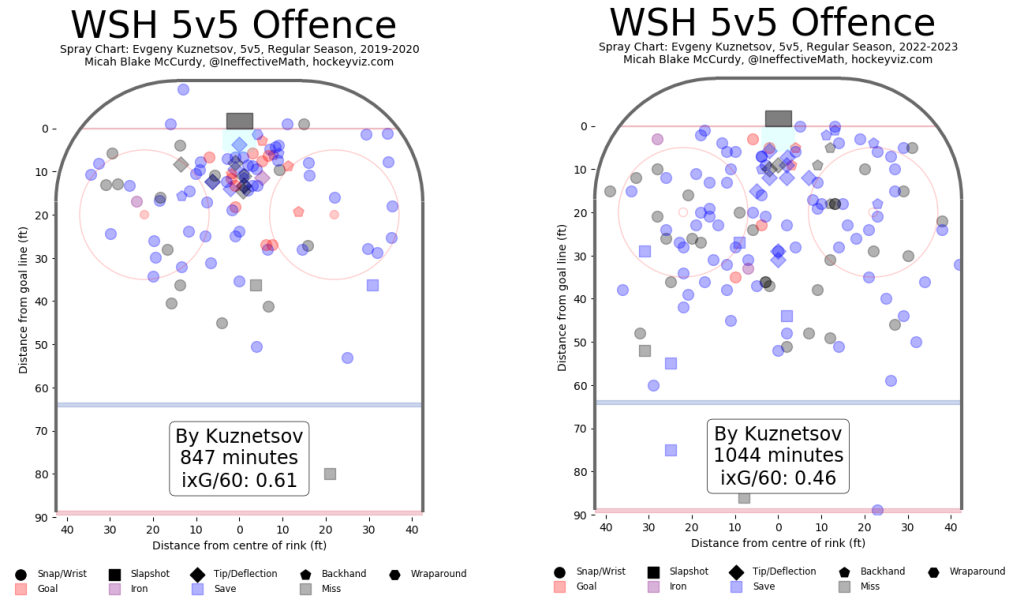
Even for a guy that shots a lot from distance, this is a bit much. It was like he tried to be the Steph Curry of the NHL – 29.9% of his shots were from at least 31 feet away this past season compared to 20.9% in 2019-20. Against a league average of 23.6%, Kuznetsov shot from distance much more often than most, and David Pastrnak he is not.
Improvements
Washington improved their offence, in some ways. They did see a rise in expected goals-for per 60 minutes at 5-on-5 this year (2.67) compared to a year ago (2.46). The league saw a rise, though, so they were basically in lockstep with that rise. Given all the injuries, though, that they kept pace with the league is a good sign.
The team's goals declined, though, as the shooting percentage declined. It is weird that happened, as Corey Sznajder's tracking data has them increasing their shots off high-danger passes by roughly 10% from last year. In other words, it seems they kept pace with the league's increased shot-quality focus but did not keep pace with goal scoring. Conor Sheary having the second-most 5-on-5 shots of any Washington forward gives some insight as to what happened with the team's offence this season.
Did anyone think that the Washington power play was better in 2022-23 than it was in 2021-22? Because it was: goals/60 minutes went up 3.7% while shot attempts/60 went up 5.2%. That is despite all the injuries they suffered to a lot of their key guys. We can thank Gustafsson and a late-season surge from Rasmus Sandin for that.
Declines
The drop in goals at 5-on-5 that we discussed was the big one. That decline in markers took them from 10th at 5-on-5 a year ago to 17th this season. It wasn't horrific but we do have to bring it up.
The bigger problem was the drop in team defence. A year ago, at 5-on-5, the team finished 10th in the league by expected goals against and 11th by actual goals against. This season, they fell all the way to 21st by expected goals against, nestled between Florida and Vancouver. It resulted them finishing 21st in actual goals against per minute and that, combined with a drop in goal scoring, led to a poor 5-on-5 season: 22nd by goal share at 5-on-5, worse than Nashville and St. Louis. Perhaps more development from Sandin and Martin Fehervary helps in this regard.
That highlights what happened to Washington in 2022-23. It wasn't as if the team completely fell off a cliff, especially when we consider the injuries they endured. There were a couple improvements and most of the declines were nibbling at the edges rather than consuming the entire team. At the risk of a bad pun, it did seem like Death By 1000 Cuts rather than just outright being a bad team. Heck, on January 5th, after their 41st game of the season, they were 12th by points percentage in the NHL, ahead of six teams that would ultimately wind up in the postseason. There was a lot of good in the first half. Injuries and under-performance from that point onward sunk the year.
Where They Go From Here
If we don't include guys they have in the minors/junior, Washington has 10 forwards under contract for 2023-24, and they're all guys that were big pieces of this team this past season or earlier. They also have four defencemen and their goaltending tandem tied up.
This is all good news because CapFriendly has them with less than $8M in cap space for next season and they have to give out a (likely) contract to UFA Sheary and RFAs Fehervary and Alexander Alexeyev (note: he was signed on May 2nd). If they can somehow get them all under contract for around $5M (that's a pipe dream, honestly), they might be able to make some small additions. Otherwise, there's very little they can do without moving money out. I've given up on predicting which guy will be the cap casualty.
The reality here is Ovechkin, Backstrom, Kuznetsov, Oshie, and Nic Dowd all have at least two years left on their contracts (Ovechkin is the exception with three), they're all on the wrong side of 30, and most of them on the wrong side of 35. Washington probably brings in some help, but it'll be like last offseason: cheap or undervalued players to help on the margins rather than an impact trade/signing. Whatever happens, the team has two years to really get one more chance at a deep playoff run with this core, so expect a lot of minor changes but no major ones.
From a fantasy perspective, there should be concerns. All these aging players don't breed a lot of confidence, especially when they didn't play particularly well in 2022-23. If the older guys don't turn it around and Kuznetsov repeats his season, how much fantasy goodness will there be outside of Ovechkin and Carlson (and Wilson in banger leagues)? Sheer attrition (read: their coach playing them regardless) probably gives them value at points, but it's hard to get excited about much here, given the unlikeliness of help coming in the offseason and all the aging players turning things around.
By the same token, the generally poor fantasy seasons for most of the Capitals skaters, driven by injury or not, will make a lot of the deep discounts at the draft table in September. It could make guys like Wilson and Oshie good values in banger leagues, for example, despite their track record of success.
Previous Offseason Reviews:

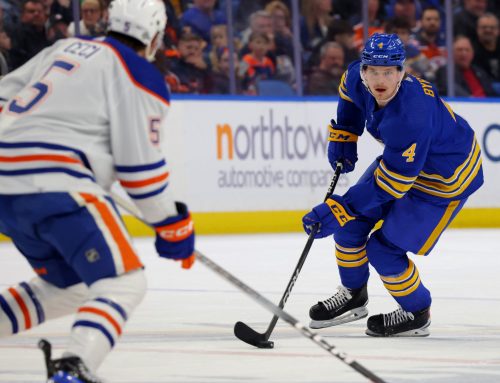
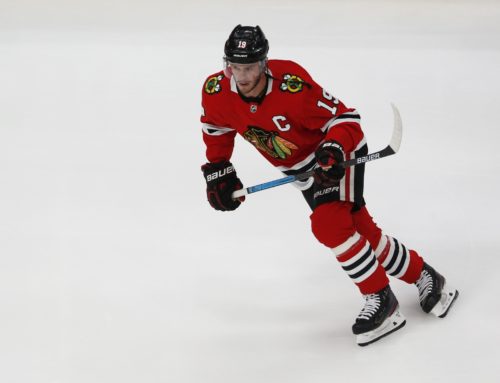
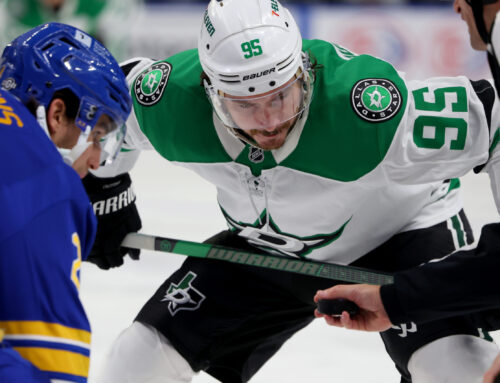
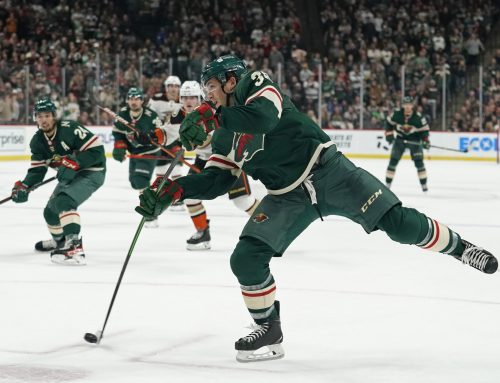
 CHI
CHI SEA
SEA FLA
FLA DAL
DAL WPG
WPG CBJ
CBJ L.A
L.A S.J
S.J N.J
N.J
